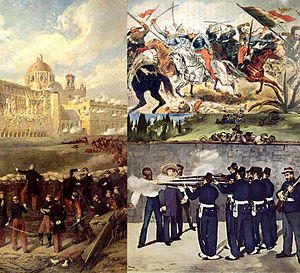French Intervention
| Franco-Mexican War | |||||||
|---|---|---|---|---|---|---|---|
 Clockwise from left: French assault during the Second Battle of Puebla; French cavalry seize the Republican flag during the Battle of San Pablo del Monte; depiction of the execution of Emperor Maximilian I by Édouard Manet. |
|||||||
|
|||||||
| Belligerents | |||||||
|
Support
|
Support
|
||||||
| Commanders and leaders | |||||||
|
|
|||||||
| Strength | |||||||
|
|||||||
| Casualties and losses | |||||||
| Total: c.12,000 dead, 8,304 wounded |
Total: c.14,000 dead Details
|
||||||
Mexican republican victory
Total: c.14,000 dead
The second French intervention in Mexico (Spanish: Segunda intervención francesa en México), also known as the Maximilian Affair, Mexican Adventure, the War of the French Intervention, the Franco-Mexican War or the Second Franco-Mexican War, was an invasion of Mexico in late 1861 by the Second French Empire, supported in the beginning by the United Kingdom and Spain. It followed President Benito Juárez's suspension of interest payments to foreign countries on 17 July 1861, which angered these three major creditors of Mexico.
Emperor Napoleon III of France was the instigator, justifying military intervention by claiming a broad foreign policy of commitment to free trade. For him, a friendly government in Mexico would ensure European access to Latin American markets. Napoleon also wanted the silver that could be mined in Mexico to finance his empire. Napoleon built a coalition with Spain and Britain while the U.S. was deeply engaged in its civil war.
The three European powers signed the Treaty of London on 31 October 1861, to unite their efforts to receive payments from Mexico. On 8 December the Spanish fleet and troops arrived at Mexico's main port, Veracruz. When the British and Spanish discovered that France planned to seize all of Mexico, they quickly withdrew from the coalition.
The subsequent French invasion resulted in the Second Mexican Empire. In Mexico, the French-imposed empire was supported by the Roman Catholic clergy, many conservative elements of the upper class, and some indigenous communities; the presidential terms of Benito Juárez (1858–71) were interrupted by the rule of the Habsburg monarchy in Mexico (1864–67). Conservatives, and many in the Mexican nobility, tried to revive the monarchical form of government (see: First Mexican Empire) when they helped to bring to Mexico an archduke from the Royal House of Austria, Maximilian Ferdinand, or Maximilian I. France had various interests in this Mexican affair, such as seeking reconciliation with Austria, which had been defeated during the Franco-Austrian War of 1859, counterbalancing the growing American Protestant power by developing a powerful Catholic neighboring empire, and exploiting the rich mines in the north-west of the country.
...
Wikipedia
